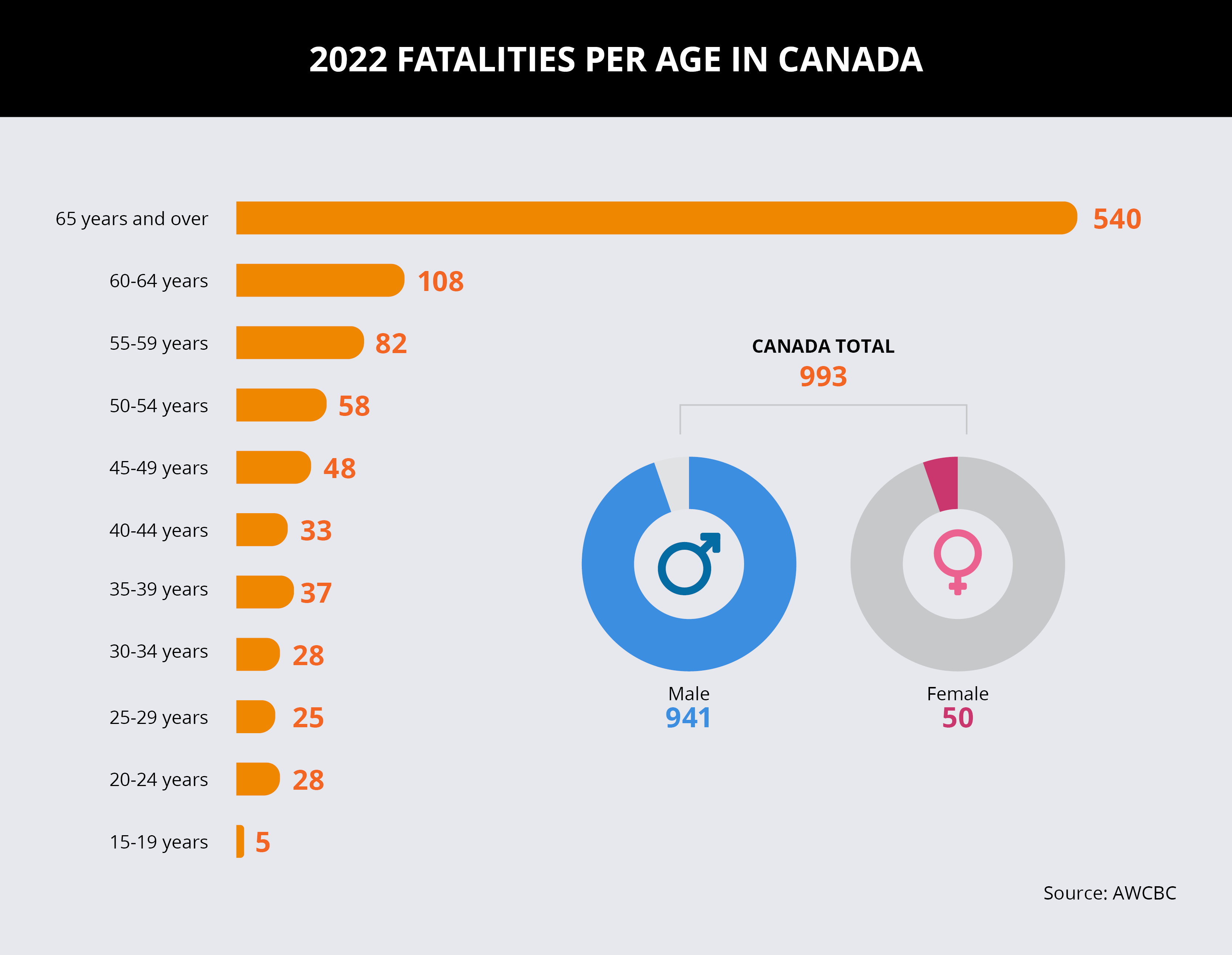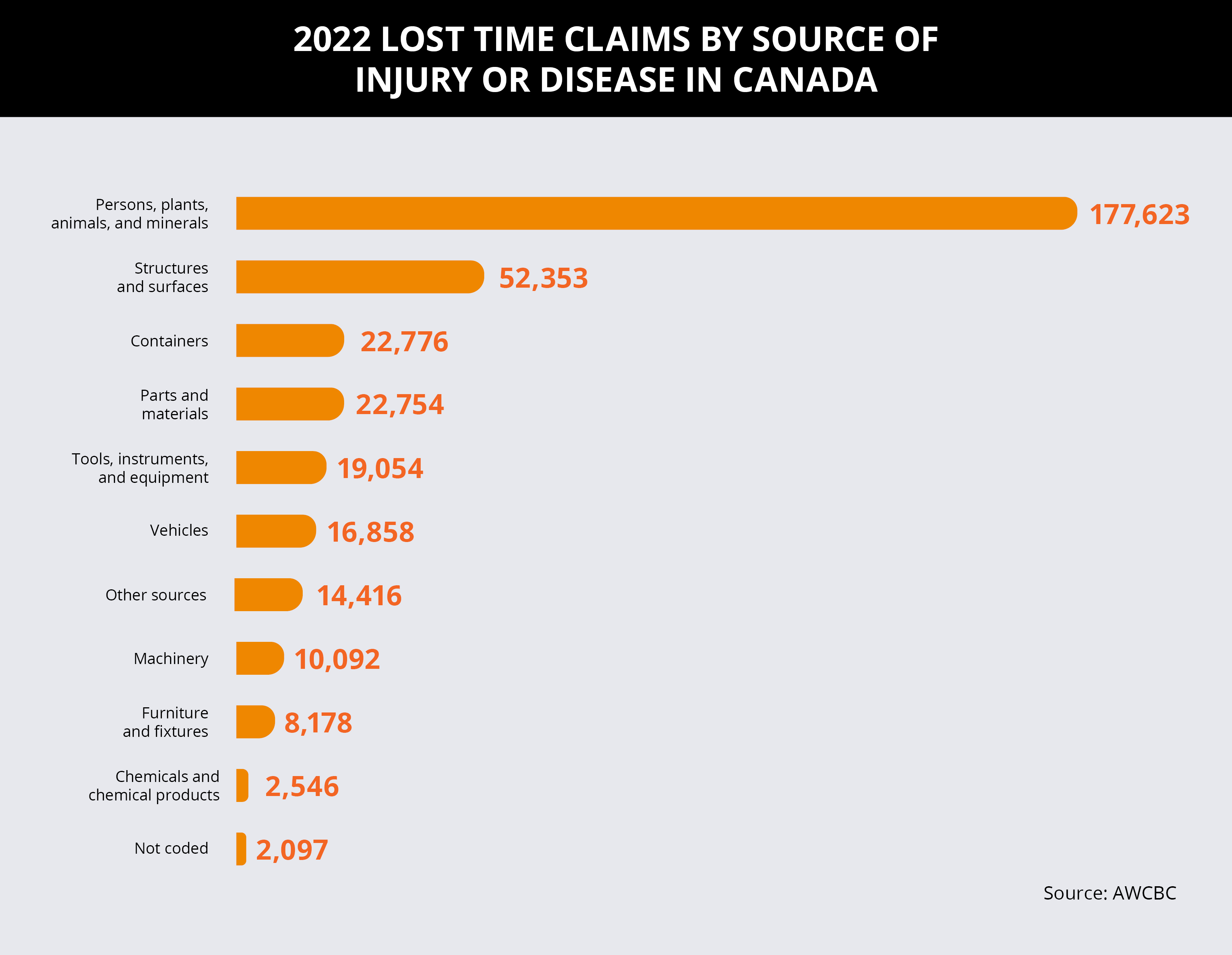

Jump to winners | Jump to methodology
“That is unacceptable because every death and injury is preventable” were the words of Bea Bruske, president of the Canadian Labour Congress in April 2024.
That was in reaction to the latest statistics showing 993 Canadian workplace fatalities in 2022, 33 of which were aged 15-24. Additionally, 348,747 accepted claims were reported for lost time due to work-related injuries or diseases, according to the Association of Workers’ Compensation Boards of Canada (AWCBC).
The total number of workers affected is predicted to be even greater than each of these totals. National research links to these figures and illustrates a lack of training is the greatest challenge to improving health and safety in the workplace, despite senior leadership and employee buy-in being widespread.
Threads of Life, a charity dedicated to supporting families after a workplace fatality, life-altering injury, or occupational disease, commissioned the members of the Angus Reid Forum to conduct a State of Safety survey. The lack of training issue was consistent across all sizes and sectors, with 55 percent of the largest companies (500+ employees) identifying it as a challenge.
Other key takeaways from the data are the following:
74% percent of respondents say their company/employer has safety training. This is the lowest (70 percent) among organizations with fewer than 100 employees. Of microbusinesses (two to nine employees), only 59 percent report having safety training in place.
A third of respondents agree that health and safety rules are a cost without much payback, and nearly a quarter agree that a certain number of accidents and injuries are the cost of doing business.
Medium-sized businesses have challenges with confusing health and safety rules and regulations, while more than a third of small and large businesses believe confusing regulations prevent them from improving safety at their workplace.
Getting buy-in for health and safety does not pose a significant challenge; overall, 80 percent reported that getting senior management buy-in is not a problem, and 70 percent reported getting employee buy-in is also not a problem.



Manager of national projects at the Canada Safety Council, Lewis Smith, believes the pandemic has brought changes to workflow and more pressure on workers.
“Especially where it concerns tasks that require the employee’s full attention, an added focus needs to be placed on psychological and mental health,” he says. “A psychologically safe worker is more confident in the support they are receiving and less likely to make errors of inattention.”
A top safety trainer distinguishes themselves by ensuring students are aware of safety measures to take and why procedures are constructed in particular ways.
“Understanding fosters a more fulsome safety culture where students feel empowered to be proactive rather than reactive,” Smith adds.
He continues, “Information will inevitably transfer if a learner feels connected with the material. A top trainer tailors their course similarly but further connects with the learner to better emphasize the methods they prefer.”
According to figures from the Saskatchewan Workers’ Compensation Board:
There were 29 workplace fatalities in 2023, compared to 39 in 2022, a decrease of 26 percent.
For the last four years, 90 percent of Saskatchewan workplaces have reported zero fatalities.
CEO of Saskatchewan Safety Council, Ryan Jacobson believes training is one of the reasons for these numbers.
“The overall trend over the last 25-30 years has generally seen increased safety engagement from workplaces in systems that include significant investments into training, system audits, and awareness building,” he says. “The awareness that injuries are not an acceptable part of work, combined with risk-based workplace systems approaches, reinforced by high-quality training, have combined over a generation, creating a cultural shift toward safe work.”
Jacobson also emphasizes the point that a variety of methods (visual, auditory, kinesthetic, etc.) have to be embraced so they connect with individuals more effectively.
He says, “Good trainers account for these different methods and try to tailor courses to reaching as wide an audience as possible. Those charged with safety roles are facing a diverse set of priorities that includes further understanding of mental health factors, remote work dynamics, emerging technology, and aligning with organizational efficiency efforts.”
COS’ 5-Star Safety and Training winners of 2024 are recognized by safety professionals nationwide for a range of criteria, including quality of training topics, feedback, pricing, and engagement with online platforms.
British Columbia-based trainer Tanya Steele has decades of experience as an occupational first aid and safety coordinator to share with students and clients in real-life scenarios.
This 5-Star Safety and Training award for her firm, TR Steele Holdings, follows up on Steele being personally recognized as a COS’ Top Women in Safety 2024.
She performs Certificate of Recognition (COR) audits, conducts site visits, and ensures all her training is:
versatile
cost efficient
solution oriented
Previously a paramedic, she dealt with workplace accidents before switching paths. Steele worked for a private ambulance company on the 1995 film Jumanji when an individual trained in first aid was needed. As a first aid day course teacher, she volunteered and was handed the role.


“That got me into construction and safety, where I’ve specialized for almost 30 years,” says Steele. “We teach more than the typical safety topics such as inspections, investigations, and due diligence; we add the human skills of working together, communication, and meeting techniques all while having fun with the goal to increase productivity by working safely and confidently.”
Steele has a particular focus on teaching COR in conjunction with the BC Construction Safety Alliance.
She says, “You look at a company’s safety program using an audit tool and find out what their programs say, and are they doing it? If an employer was doing what they say, they would get a rebate back on their costs.”
Steele also teaches joint health and safety committee training, as in Canada there are several mandatory issues where directors and workers come together on, including:
recognizing and evaluating workplace hazards and risks that may cause incidents, injuries, and illness
participating in the development and implementation of programs to protect employees’ safety and health
responding to employee complaints and suggestions
ensuring maintenance and monitoring of injury and work hazard records
monitoring and following up on hazard reports and recommending action

Steele leverages technology to enhance her training, and it also enables clients to provide enhanced feedback.
She says, “I do not do webinar-style training. I don’t just show a PowerPoint and talk at people. Clients say that my virtual live training on Zoom is more engaging than even our in-person course.
“I use all sorts of technology, such as chat, breakout rooms, and whiteboards. I use Ecamm Live, which means I can write and get other people to write on my screen. We have learned the art of getting people fully engaged online.”
During in-person sessions, Steele employs roleplay to help clients better understand potential workplace risks and dangers.
She says, “People sometimes roll their eyes when they hear we’re doing role play, but 99 percent of the time in our surveys, clients say it is the best part about the class. We pick an incident and do a full investigation. We have actors and personalities, and they interview them.”
Steele also helps companies rejuvenate their joint health and safety committee.
“We show them how to run an effective meeting, giving them skills and techniques they can implement that will increase the effectiveness of their committee a hundredfold,” she says.
For Steele, the need to make health and safety procedures more accessible for employees is paramount.
“Companies have safety manuals that can be up to 900 pages, and if you read through them, it doesn’t really say anything,” she says. “Employers use these very general terms that don’t really tell employees what they should and shouldn’t do. They have lost sight of who they’re writing the manual for.”
Effective training offered by Steele and the other COS’ 5-Star Safety and Training winners makes a difference.

Two of the biggest causes of workplace fatalities in Canada are falls to lower levels and exposure to caustic, noxious, or allergic substances. If a hypothetical 18-year-old employee reads his health and safety manual but the information is not easily understandable and wholly accessible, then he is in danger of becoming another fatality.
“They might read the manual, and it says, ‘Go to the CSA standard’ for what they’re supposed to do. It costs between $100 and $300 to purchase that,” explains Steele. “Sometimes they may have access to it, but it’s written in legalese. Most workers just want to know what PPE they must wear, what the hazards are, and what training is needed.”

Steele’s training aims to counter this issue of overcomplexity and save lives. By not understanding safety manuals and procedures, workers are not confident in their duties and could potentially injure themselves or colleagues.
“We ensure that each student and employer get exactly what they need and that they leave with tools and skills to make a difference. We teach and mentor companies on how to write their manual so when a worker reads it, it makes sense. Our slogans are ‘Safety Makes Sense’ and ‘Work with Confidence’,” adds Steele.
In June, Canadian Occupational Safety researchers interviewed and surveyed safety professionals across the country to find out who they recognized as the top safety trainers for the fourth annual 5-Star Safety and Training.
The participants were first quizzed on what features they thought were most important in choosing a safety trainer and then asked to recommend trainers and training companies. Participants rated the trainers and companies across a range of criteria, including the quality of training topics, feedback, pricing, and online platforms.
Companies and individuals who received a score of at least 80 percent were named 5-Star award winners in recognition of their excellent services and programs.